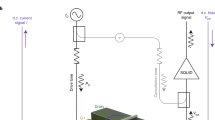Abstract
In this paper, we propose the mathematical model of a novel device, the nanomechanical transistor, able to control a current through a small drive voltage. The novelty of the device relies in its mechanical working principle where nanopillars vibrate between electrodes under a self-excitation regime which provides a continuative electric charge transportation. The dynamics of the investigated system involves electromechanical phenomena with the addition of quantum effects due to the electron tunneling of charges from pillars to electrodes. The theory here presented is an attempt to build a general model for those multiphysics phenomena (electrical-mechanical with presence of quantum effects) frequently met in nanotechnology that do not fit yet into a systematic frame.






Similar content being viewed by others
References
Sheible D, Blick R (2005) Electromechanical electron transfer device. Patent US 6946693
Maurini C, dell’Isola F, Del Vescovo D (2004) Comparison of piezoelectronic networks acting as distributed vibration absorbers. Mech Syst Signal Process 18:1243–1271
dell’Isola F, Vidoli S (1998) Continuum modelling of piezoelectromechanical truss beams: an application to vibration damping. Arch Appl Mech 68:1–19
Maurini C, Pouget J, dell’Isola F (2004) On a model of layered piezoelectric beams including transverse stress effect. Int J Solids Struct 41:4473–4502
Ollier E, Labeye P, Revol F (1995) Micro-opto mechanical switch integrated on silicon. Electron Lett 31(23):2003–2005
Toshiyoshi H, Fujita H (1996) Electrostatic micro torsion mirrors for an optical switch matrix. J Microelectromech Syst 5(4):231–237
Westervelt RM (2008) Graphene nanoelectronics. Science 320(5874):324–325
Li C (2004) Vibrational behaviors of multiwalled-carbon-nanotube-based nanomechanical resonators. Appl Phys Lett 84(1):121–123
Bauerdick S et al. (2006) Direct wiring of carbon nanotubes for integration in nanoelectromechanical systems. J Vac Sci Technol B 24:3144
Gorelik LY et al. (1998) Shuttle mechanism for charge transfer in Coulomb blockade nanostructures. Phys Rev Lett 80(20):4526–4529
Isacsson A et al. (1998) Shuttle instability in self-Assembled Coulomb blockade nanostructures. Phys B Condens Matter 255(1–4):150–163
Isacsson A (2001) Dynamics of a three-terminal mechanically flexible tunneling contact. Phys Rev B 64:035326
Novotný T, Donarini A, Jauho AP (2003) Quantum shuttle in phase space. Phys Rev Lett 25(Pt 1):256801
Pistolesi F, Fazio R (2005) Charge shuttle as a nanomechanical rectifier. Phys Rev Lett 94:036806
Isacsson A, Gorelik LY et al. (1998) Shuttle instability in self-assembled Coulomb blockade nanostructures. Physica B 255:150
Simmons GJ (1963) Generalized formula for the electric tunnel effect between similar electrodes separated by a thin insulating film. J Appl Phys 6:34
Lenstra D, Smokers RTM (1988) Theory of nonlinear quantum tunneling resistance in one-dimensional disordered systems. Phys Rev B 10:38
Russell MA (1921) The capacity coefficients of spherical electrodes
Rawlins AD (1985) Note on the capacitance of two closely separated spheres. IMA J Appl Math 34:119–120
Ostoja-Starzewskia M, Woods A (2003) Spectral finite elements for vibrating rods and beams with random field properties. J Sound Vib 268:779–797
Carcaterra A, Dessi D, Mastroddi F (2005) Hydrofoil vibration induced by a random flow: a stochastic perturbation approach. J Sound Vib 283:401–432
Carcaterra A (2005) Ensemble energy average and energy flow relationships for nonstationary vibrating systems. J Sound Vib 288:751–790
Culla A, Sestieri A, Carcaterra A (2003) Energy flow uncertainties in vibrating systems: definition of a statistical confidence factor. Mech Syst Signal Process 17(3):635–663
Eremeyev VA et al. (2007) Method of determining the eigenfrequencies of an ordered system of nanoobjects. Theor Math Phys (Zh Tekhn Fiz) 77(1):3–8
Ardito R et al. (2008) Solid damping in micro electro mechanical systems. Meccanica 43:419–428
Kaminski M, Corigliano A (2011) Sensitivity, probabilistic and stochastic analysis of the thermo-piezoelectric phenomena in solids by the stochastic perturbation technique. Meccanica ISSN 0025-6455. doi:10.1007/s11012-011-9458-5
Luongo A et al. (1998) Postcritical behavior of cables undergoing two simultaneous galloping modes. Meccanica 33(3):229–242
Luongo A et al. (2005) A multiple timescales analysis for 1:2 and 1:3 resonant Hopf bifurcations. J Sound Vib 288(4–5):1027–1047
Karabalin RB, Cross MC, Roukes ML (2009) Nonlinear dynamics and chaos in two coupled nanomechanical resonators. Phys Rev B 79:165309
Author information
Authors and Affiliations
Corresponding author
Appendix
Appendix
The quantum tunneling occurring between two electrodes at nanometer distance can be estimated by introducing an equivalent, non-linear conductance term G t . Different closed-form relations exist in literature to calculate G t . In general, given the geometry of the system, the tunneling conductance depends on both the distance d and the potential difference V between the electrodes. In this article we use the Simmons formulae [16], referred to a rectangular barrier with image forces included. Therefore:

where S=40 nm2 is the surface exposed to tunnel, φ 0=5 eV the conductor working function, m el the electron mass, and:

Notice that (29) is valid when the potential barrier is above the Fermi level. When the distance between electrodes is reduced over a certain threshold, the current flows unimpeded in the conduction band of the insulator. To include this condition in the model for G t , we used the saturation value G c =γ c S, with γ c =1011 S/m2, representing the contact conductance. Consequently, the model used in this article takes into account both charge transfer mechanisms: quantum tunneling and contact conduction. Application of Eq. (29) to the present model produces:
Rights and permissions
About this article
Cite this article
Scorrano, A., Carcaterra, A. Investigation on a nanomechanical transistor. Meccanica 48, 1883–1892 (2013). https://doi.org/10.1007/s11012-013-9746-3
Received:
Accepted:
Published:
Issue Date:
DOI: https://doi.org/10.1007/s11012-013-9746-3




